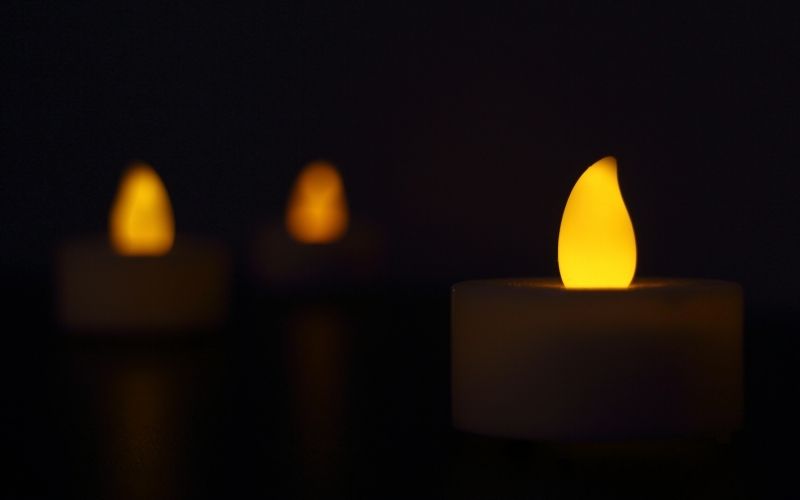Candle warmers help candle scent enthusiasts burn their candle wax and candles safely. These warmers are less likely to trigger fire outbreaks because they don’t use an open fire.
Candle warmers are generally safe to use and will not cause a fire. However, they still pose a risk when left on for too long. While open flame risks are minimal, they can overheat, causing electric wire damage, and electrocution from water spills.
The risk depends on how long the candle warmer is left working. To understand more about how this works, keep reading for more insights.
Contents
- Why Should You Use Electric Candle Warmers?
- Why Do Candle Warmers Never Catch Fire?
- Potential Risks that Come with Leaving the Warmer Unmanned
- Is it Safe to Use Wax Warmers?
- Tips to Help You Use the Warmer Safely
- What Happens when the Warmer Remains On for Long?
- How Long Should the Warmer Be On?
- Final Thoughts
Why Should You Use Electric Candle Warmers?
Candle warmers offer a safe and convenient way to burn scented wax. They help illuminate a space and slowly release the sweet scent from the wax. What’s more, one does not have to light the candle wick to melt the candle.

Since these warmers don’t have an open fire, the dangers posed by real flames are non-existent. Even though the safety levels are low when using warmers, one still needs to exercise caution.
Be careful about how long you leave the candle warmer working. Burning your candles for extended periods has its risks. If possible, never leave your warmer without proper supervision.
Why Do Candle Warmers Never Catch Fire?
These unique devices do not require a real flame to work. What’s more, the candle wax used on them has no wick.
Ideally, candle warmers do not pose any fire-related accidents. However, since they need a heat source to work, they could cause minor accidents when left on for long hours.
As such, one should avoid leaving their candle warmer burning overnight. You never know what could happen.
Potential Risks that Come with Leaving the Warmer Unmanned
While you will not necessarily babysit the warmer, avoid leaving it on for long periods. Several things could go wrong with this.
The device may overheat or develop electrical faults that could trigger serious issues. There is also the possibility of the chord being a trip hazard.
The warmer could also lead to smoking, especially when the candle is too close to the burner/ lamp. In addition, some people may experience electrocution when fluid spills on the warmer.
Is it Safe to Use Wax Warmers?
Electric candle wax warmers are a great alternative to burning scented candles. They receive heat from an electric source.
What’s more, these devices produce no flame. This makes them safe to use. However, users should switch off the device after a few hours of use, especially when sleeping.
Note that most manufacturers use paraffin wax. This wax is not entirely safe for human health. It may contain benzene and thus should not be burned for extended periods.
Benzene is a potential risk factor for blood disorders and cancer. Therefore, it is advisable not to burn your candles for too long to limit overexposure.
Tips to Help You Use the Warmer Safely
With all the potential risks involved when using candle warmers, one may wonder how best to guarantee safety. However, a few tips can help users safely enjoy their candle melting devices.
1. Read the Tips on the Manual

The manufacturer knows the merits and demerits of the candle warmers. As such, they will attach a user manual and guide. Please read all the tips and follow them when needed.
Reading the manual helps you familiarize yourself with the device. As a result, you can avoid common mistakes.
2. Consider the Voltage Setting
Each candle warmer comes with a voltage setting specification. Ensure that yours matches that of your home’s power socket. Also, use the recommended bulb wattage.
Compatibility is key as it prevents damage to the device or potential risks to the users.
3. Position the Warmer Safely

Choose an appropriate place to keep the candle warmer. Place it away from combustible materials. Even though there are no real flames, the explosive material can catch fire when the warmer overheats.
The recommended practice is to have the warmer in an open place. This minimizes the risks of any fires or related risks.
4. Handle the Warmer with Dry Hands-Only
Your candle warmer is electronically powered. Consequently, avoid using it with wet hands. The last thing you want is to get electrocuted.
Dry your hands before use. If the warmer gets wet, avoid using it until such a time that it is dry.
5. Use the Warmer when It is Producing Smoke or Strange Scents
You may notice strange smells and smokes when the warmer overheats. Sometimes the same happens if the wax’s melting point is too low.
Always remove the used wax from the candle warmer. Be sure that the warmer is cooled and the wax is hard and cool.
6. Do Not Use Paraffin Wax

There are different types of wax melts you will find in the market. Stay away from paraffin wax melts. These pause several health risks to humans when inhaled.
There are several wax alternatives you could explore. Consider using soy wax, but you should also limit its use. It is not always possible to find a complete natural soy wax today.
The better option would be essential oil wax melts. These are always safe to use.
What Happens when the Warmer Remains On for Long?
Several potential outcomes may result when warmer remains on for too long. First, it may overheat. This will cause smoke or bad odors.
If possible, go for warmers auto shut-offs to eliminate the risks.
Second, the warmer may get damaged by the electricity.
How Long Should the Warmer Be On?
The duration depends on the warmer type. For example, tea light warmers can stay plugged in for 9 hours. On the other hand, electric warmers can go up to 10 to 12 hours.

Note that when candles exceed their maximum limit, they cease producing good scents. As a result, electric warmers tend to overheat and become a risk factor.
Final Thoughts
Candle warmers are safer than open flames as they will not catch fire. However, you need to exercise caution and not exceed recommended running period.

I currently work as a medical receptionist, but my ultimate goal is to work as an occupational therapy assistant. Helping others achieve a better quality of life is something I’m after. That’s one of the main reasons I started this blog. Learn more about me.
